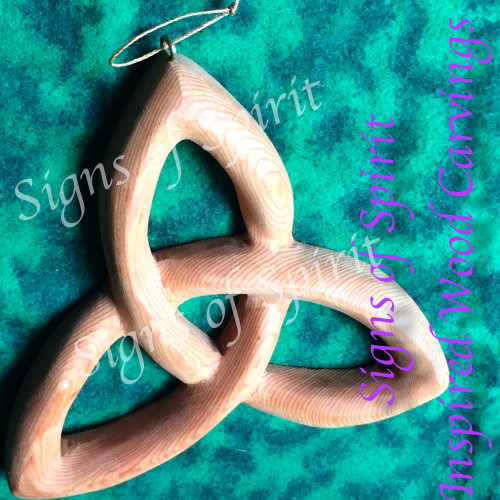MEANING: The symbol is a combination of two of the most basic Triquetras, The Trinity Knot. Simply three arcs; originally it is believed to the early Celts, the three arcs represent the three aspects of the ancient Celtic Goddess; Maiden, Mother, Crone which reflect the Phases of Womanhood.
Later, as Christianity spread, this Celtic triangle was adapted to the Christian trinity of Father, Son and Holy Spirit.
Coop draws this Double Trinity with compass and ruler, one Trinity knot on top of the other, inverted 180 degrees. While maintaining 2 separate knots, he then weaves the trinities together. This can then represent the finding of balance between dualities; the matriarchal and patriarchal trinities, female/male, etc.
The final wood carving also has the advantage of being very much like a six petaled flower!
THE CARVING: Our carvings are single pieces of western red cedar, designed and carved to be wall hangings. Each carving begins as a 1 X 12 inch cedar board. While we use power tools (Scroll Saw, Rotary shaft Tool, handheld detail sanders etc.), we use no laser’s, CNC machines or computer operated cutting machines. All work is done with our hands and eyes…
We cut the 2 dimensional blanks with scroll and jig saws (double-sized custom orders have to be cut with jigsaw). Carving is done with rotary shaft tools and disc grinders. The 80 grit sanding is the final phase of the carving process, removing the nicks and gouges from the carving tools, and finishes the shaping of the weave. The next 2 sandings with 120 then 220 grit finishes the smoothing and polishing. They are finished with Clear Danish Oil to seal the piece, bringing out the grain and the color.
SIZE: One picture has the piece on a quilting board. The quilting board, at its simplest, is a one inch grid. So with the piece on the board, you look at the top and follow the line to the left and look at the right side at the widest point and follow the line to the bottom and you have height by width. Measurements may vary slightly from piece to piece.













